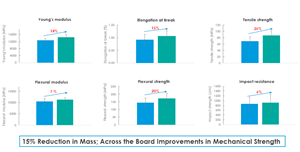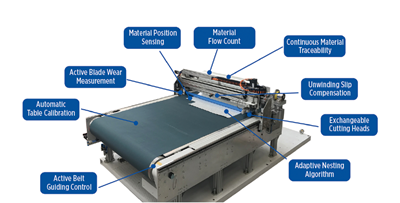Ply stacking, cutting process optimized via automation, smaller footprint
CAMX 2024: Schmidt & Heinzmann customers are able to produce SMC or dry fiber fabric stacks more efficiently thanks to the AutoCut Pick&Place system.
Share
Schmidt & Heinzmann (Bruchsal, Germany) highlights the AutoCut Pick&Place, a solution for more efficient and automated composite parts manufacturing. The compact system is said to redesign the automated cutting, weighing and stacking of sheet molding compound (SMC) materials as well as dry fiber fabrics.
AutoCut Pick&Place maintains the more well-known features of the company’s AutoCut system: generic software enables simple programming and faster materials production, different cutting technologies are available for various materials (SMC, prepregs, dry fiber fabrics, etc.) and an automated compensation function ensures correct stack weights. Adding on to this is a smaller footprint option for stacking and weighing plies directly onto the AutoCut — in this case, an integrated gantry system with a multifunctional gripper builds the stack. Compared to a traditional machine concept, Schmidt & Heinzmann says a handling robot achieves faster handling due to shorter traveling distance and faster installation and startup thanks to integrated functions.
Schmidt & Heinzmann has been developing and producing tailor-made production machinery and automation solutions for composites for more than 50 years. Its product portfolio includes:
- Cutting systems for all kind of fibers
- SMC production machinery
- Automated cutting and stacking systems for dry fiber fabrics and SMC semi-finished materials
- Preforming systems for the automated production of glass and carbon fiber preforms
- Press automation for manufacture of SMC and WCM components
- Customized solutions.
The company, with offices in the U.S. and China and more than 130 employees, generated a turnover of €20 million in 2023.
Related Content
-
Composite materials, design enable challenging Corvette exterior components
General Motors and partners Premix-Hadlock and Albar cite creative engineering and a move toward pigmented sheet molding compound (SMC) to produce cosmetic components that met strict thermal requirements.
-
Composite resins price change report
CW’s running summary of resin price change announcements from major material suppliers that serve the composites manufacturing industry.
-
Graphene-enhanced SMC boosts molded component properties
CAMX 2023: Commercially sold GrapheneBlack SMC from NanoXplore increases part strength, stiffness and provides other benefits for transportation, renewable energy, energy storage and industrial markets.
Related Content
Composite materials, design enable challenging Corvette exterior components
General Motors and partners Premix-Hadlock and Albar cite creative engineering and a move toward pigmented sheet molding compound (SMC) to produce cosmetic components that met strict thermal requirements.
Read MoreComposite resins price change report
CW’s running summary of resin price change announcements from major material suppliers that serve the composites manufacturing industry.
Read MoreGraphene-enhanced SMC boosts molded component properties
CAMX 2023: Commercially sold GrapheneBlack SMC from NanoXplore increases part strength, stiffness and provides other benefits for transportation, renewable energy, energy storage and industrial markets.
Read MoreComprehensive service formulates standard, custom SMCs
CAMX 2024: As an SMC product manufacturer, Molding Products LLC provides SMC formulations and technical support for diverse markets, from R&D to post-production.
Read MoreRead Next
Schmidt & Heinzmann earns TOP 100 Innovator award
For the second year in a row, the composites equipment and machinery company has been recognized for its innovation in equipment, processes and customer involvement.
Read MoreModular cutting and stacking system advances flexible, fully automated operations
Integration of next-gen cutting and stacking systems into production lines brings new level of efficiency, quality control.
Read More“Structured air” TPS safeguards composite structures
Powered by an 85% air/15% pure polyimide aerogel, Blueshift’s novel material system protects structures during transient thermal events from -200°C to beyond 2400°C for rockets, battery boxes and more.
Read More










